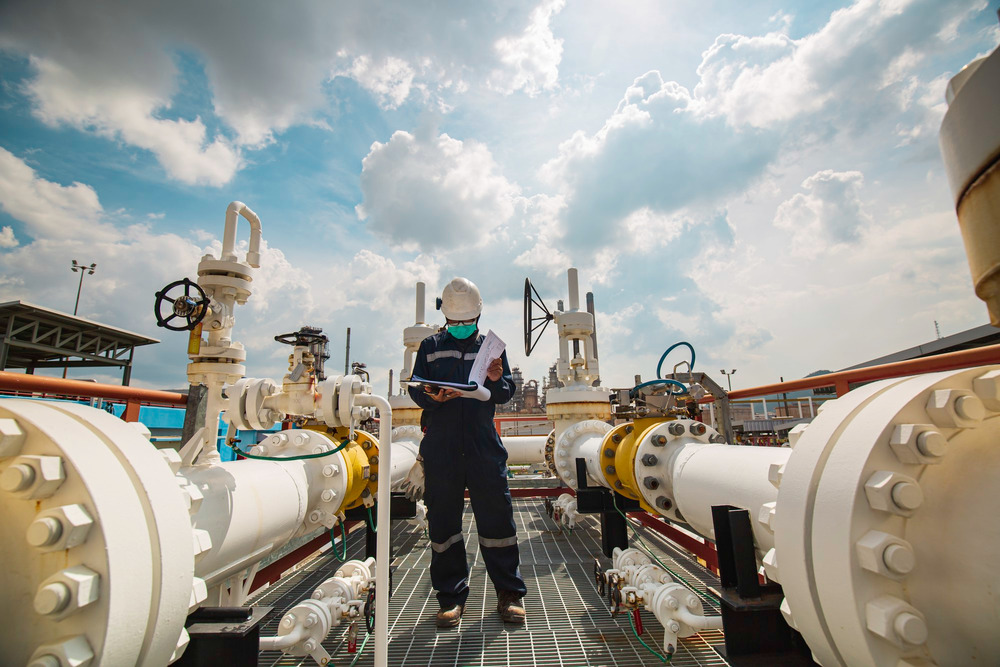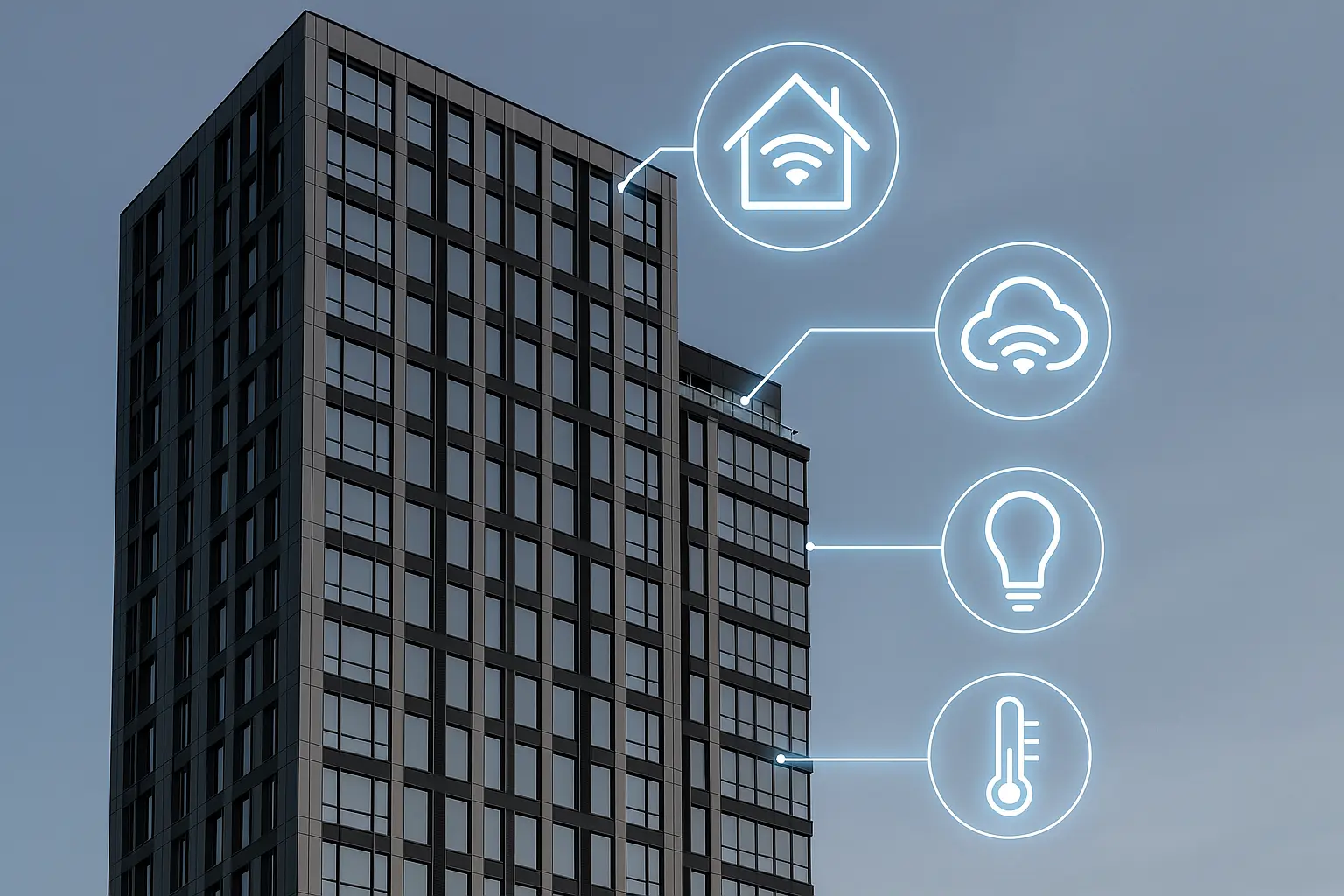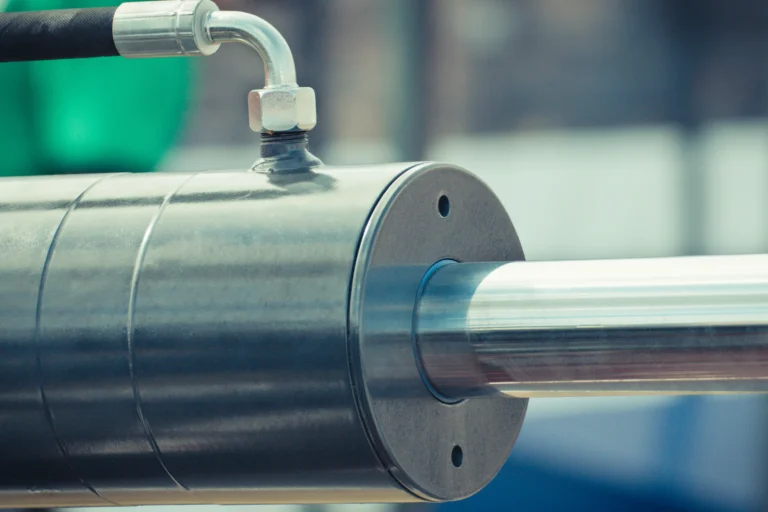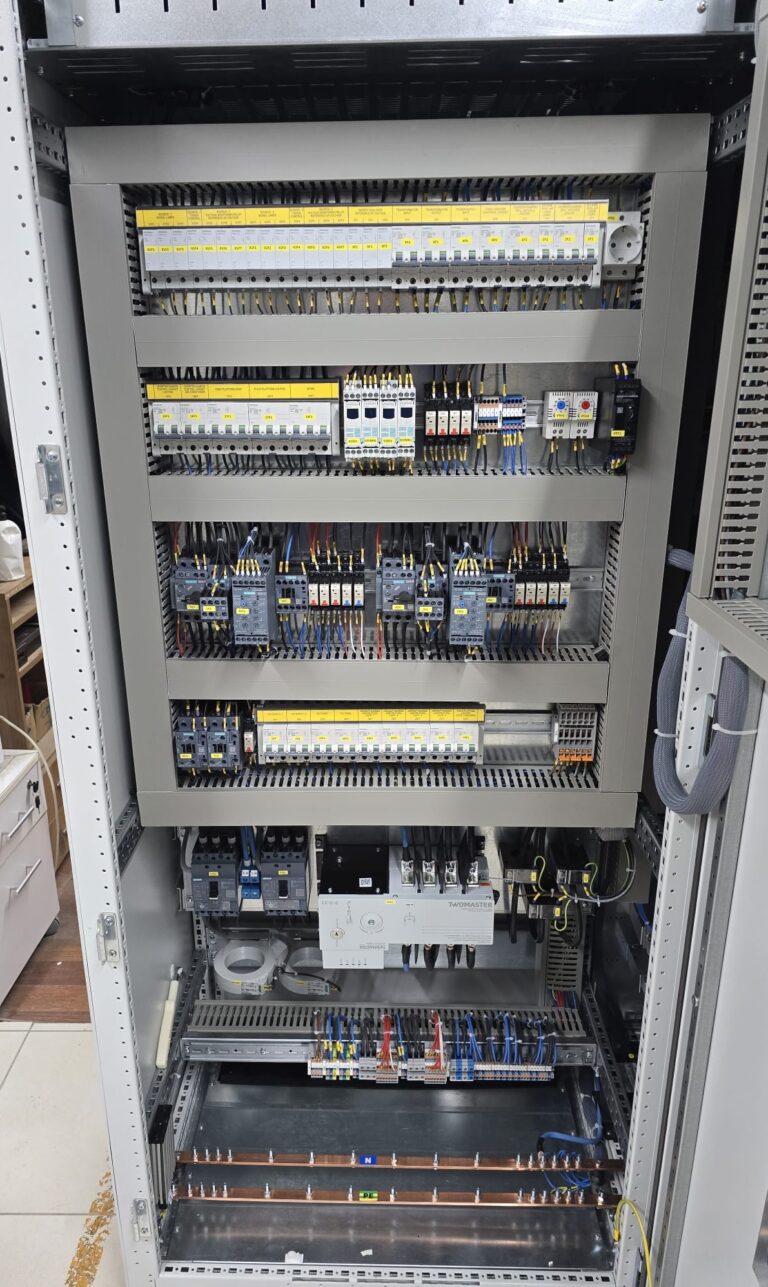What is an Actuator and How Does it Work?
An actuator is a key component in many engineering and automation system, acting as the bridge between control signals and...
Devamını Oku

As technology evolves, the spaces we live and work in are also becoming smarter, more secure, and more efficient. At the core of this transformation lie smart building solutions that go far beyond improving comfort. These systems enhance energy optimization, strengthen safety, and lay the foundation for sustainable living. A smart building can collect and analyze data and make automated decisions based on real-time conditions. With the integration of sensors, control systems, IoT devices, and software platforms, smart buildings offer highly manageable and cost-effective environments for both individuals and organizations.
Especially in large structures and industrial facilities, smart building systems increase operational efficiency while reducing environmental impact. These systems automate critical building functions like lighting, energy management, climate control, and security. In our increasingly digital world, smart building applications play a key role in helping organizations meet their sustainability and innovation goals. In this article, we will explore what is a smart building, its most important smart building features, and the technologies that make them work. We’ll also answer the question: what are smart building systems, and how companies like Adatech help shape this transformation with cutting-edge engineering.
A smart building is an advanced structure equipped with interconnected systems that can monitor, analyze, and manage various building functions autonomously. It uses real-time data gathered from sensors and control units to make intelligent decisions that improve efficiency, safety, and comfort. These systems work together to optimize lighting, temperature, air quality, and other environmental factors while reducing energy waste and human intervention.
To answer the question what is a smart building, it’s a structure that goes beyond traditional operations by integrating technology into its core. Through automation and data-driven processes, it becomes more adaptive to occupants’ needs and external conditions. This digital transformation allows smart buildings to operate more sustainably and efficiently, making them a fundamental part of future-ready cities and industries.
One of the core smart building features is its ability to respond intelligently to changing internal and external conditions. Equipped with a network of sensors, these buildings constantly monitor variables such as temperature, humidity, occupancy, and air quality. The system automatically adjusts heating, cooling, and lighting levels to maintain optimal comfort while conserving energy. This level of automation reduces manual control, lowers costs, and increases user satisfaction.
Smart buildings also emphasize sustainability, security, and system integration. They often include biometric access systems, motion detectors, fire safety technologies, and real-time surveillance. These features not only enhance safety but also provide insights into building usage patterns. Combined with centralized management, these intelligent systems help organizations meet regulatory standards while delivering a high-performance built environment.
Smart building systems refer to the integrated technologies that control, automate, and optimize a building’s core operations. These systems manage everything from HVAC, lighting, and security to fire safety, water usage, and energy distribution. They are interconnected through sensors, actuators, and intelligent software that communicate with one another in real-time. This creates a synchronized environment where various systems work together seamlessly under a central management platform.
To answer the question what are smart building systems, they are not limited to individual solutions but function as part of a unified ecosystem. Depending on the building’s purpose, different systems may be prioritized—such as energy efficiency in offices or security in industrial sites. Their primary goal is to reduce waste, increase control, and create adaptive, self-regulating environments that improve long-term building performance.
At the heart of smart building systems lies energy management and automation. These systems monitor and regulate lighting, HVAC, and equipment usage based on real-time demand. By automatically adjusting energy consumption, buildings reduce operational costs and carbon footprint. Predictive controls and analytics help fine-tune performance, leading to smarter, greener, and more cost-effective infrastructure.
Smart building applications integrate systems that ensure both safety and comfort. Intelligent lighting adjusts based on occupancy and daylight, while climate control systems maintain ideal indoor conditions. Security features include surveillance, access control, and alarm systems—all connected to a centralized platform. This integration allows for real-time responses and greater operational efficiency across the entire building.
Modern smart building solutions rely on smart grids to optimize energy flow and enhance sustainability. These grids connect buildings to broader energy networks, enabling load balancing, peak shaving, and real-time energy pricing. Integration systems ensure seamless communication between different technologies, allowing buildings to automatically respond to energy supply conditions and maintain high performance without manual intervention.
In today’s technology-driven environment, buildings are becoming more than just physical spaces—they are turning into intelligent ecosystems. Smart building solutions provide integrated technologies that improve energy efficiency, automate operations, enhance security, and support environmental goals. These solutions are tailored to the specific needs of a building, offering scalability for everything from small offices to large industrial complexes.
By combining sensors, IoT devices, centralized control systems, and analytics software, smart buildings become proactive rather than reactive. These technologies allow for predictive maintenance, real-time monitoring, and remote management. Engineering experts like Adatech design and implement custom solutions that ensure seamless functionality across all systems. As a result, smart buildings not only perform better but also offer significant long-term savings and operational control.
IoT and sensor-based technologies are essential components of smart building systems. These sensors monitor occupancy, temperature, humidity, lighting, and air quality in real time. Connected through the Internet of Things, devices communicate data to central systems that automate responses—like dimming lights or adjusting ventilation—creating a responsive, energy-efficient, and user-centered environment.
Centralized automation platforms are the brain behind smart building applications. These systems provide a unified interface to monitor and control lighting, HVAC, security, and energy usage. By aggregating data from multiple sources, they allow facility managers to optimize operations in real time. This leads to improved decision-making, quicker response times, and significantly reduced operational costs.
Among the most valuable smart building features are those that promote sustainability and energy efficiency. Advanced systems monitor usage patterns and optimize resources such as electricity, water, and HVAC. Automated adjustments minimize waste while maintaining comfort. These technologies support green building certifications and help organizations meet environmental targets without sacrificing operational performance.

An actuator is a key component in many engineering and automation system, acting as the bridge between control signals and...
Devamını Oku
An MCC panel (Motor Control Center) is an essential electrical distribution system used in industrial facilities to control and manage...
Devamını Oku
In today’s rapidly evolving energy landscape, adaptable and innovative technologies play a crucial role in shaping national and global energy...
Devamını OkuPROTECTION OF PERSONAL DATA
WEBSITE COOKIE POLICY
Your personal data; It is one of the leading principles of our Organization to protect the privacy of visitors to the website (www.adatech.com.tr) operated by ADATECH as the data controller. This Cookie Usage Policy (“Policy”) explains to all our website visitors and users which types of cookies are used and under what conditions.
Cookies are small text files stored on your device or network server by websites you visit on your computer or mobile device.
They are generally used to provide you with a personalized experience during your use of the website you visit, to improve the services offered and to improve your experience, and may contribute to ease of use while browsing a website. If you do not prefer the use of Cookies, you can delete or block Cookies in your browser settings. However, we would like to remind you that this may affect your use of our website. Unless you change your cookie settings in your browser, we will assume that you accept the use of cookies on this website.
1. WHAT KIND OF DATA IS PROCESSED IN COOKIES?
Cookies on websites, depending on their type, collect data about your browsing and usage preferences on the device you visit the site. This data includes information about the pages you access, the services and products you review, your preferred language option and other preferences.
2. WHAT is a solution and what are its intended uses?
Cookies are small text files that are stored on your device or network server through browsers by websites you visit. These small text files, which contain your preferred language and other settings on the site, help us remember your preferences the next time you visit the site and make improvements to our services to improve your experience on the site. Thus, you can have a better and personalized usage experience on your next visit.
The main purposes of using cookies on our Website are listed below:
3.TYPES OF COOKIES USED ON OUR WEBSITE
3.1. Oturum Çerezleri
Session cookies ensure that the website functions properly during your visit. They are used for purposes such as ensuring the security and continuity of our sites and you during your visit. Session cookies are temporary cookies, they are deleted when you close your browser and come to our site again, they are not permanent.
3.2. Persistent Cookies
These types of cookies are used to remember your preferences and are stored on your device via browsers. Persistent cookies remain stored even after you close your browser or restart your computer from which you visited our site. These cookies are kept in subfolders of your browser until they are deleted through your browser’s settings.
Some types of persistent cookies may be used to provide you with special suggestions, taking into account issues such as your purpose of using the Website.
Thanks to persistent cookies, if you visit our Website again with the same device, it is checked whether there is a cookie created by our Website on your device and if there is, it is understood that you have visited the site before and the content to be transmitted to you is determined accordingly and thus a better service is provided to you.
3.3. Mandatory/Technical Cookies
These cookies are essential for the website you visit to function properly. The purpose of such cookies is to provide necessary services by enabling the website to function. For example, it allows you to access secure parts of the website, to use its features, to navigate on it.
3.4. Analytical Cookies
They collect information about the way the website is used, the frequency and number of visits, and show how visitors navigate to the site. The purpose of using such cookies is to increase performance by improving the way the site functions and to determine the general trend direction. They do not contain data that could enable the identification of visitors. For example, they show the number of error messages displayed or the most visited pages.
3.5. Functional/Functional Cookies
It saves the choices made by the visitor within the site and remembers them on the next visit. The purpose of such cookies is to provide ease of use to visitors. For example, it prevents the site user from re-entering the user password on each page they visit.
3.6. Targeting/Advertising Cookies
They enable the measurement of the effectiveness of advertisements served to visitors and the calculation of the number of times the advertisements are viewed. The purpose of such cookies is to serve ads customized to the interests of visitors.
Likewise, they enable the detection of visitors’ interests specific to their browsing and the presentation of appropriate content. For example, it prevents the advertisement shown to the visitor from being shown again in a short time.
4. HOW TO MANAGE COOKIE PREFERENCES?
To change your preferences regarding the use of cookies or to block or delete cookies, simply change your browser settings.
Many browsers give you the option to accept or reject cookies, accept only certain types of cookies, or be alerted by the browser when a website requests to store cookies on your device so that you can control cookies.
It is also possible to delete cookies previously saved in your browser.
If you disable or refuse cookies, you may need to set some preferences manually, some features and services on the website may not function properly as we will not be able to recognize and associate your account. You can change the settings of your browser by clicking on the relevant link from the table below.
5. ENFORCEMENT OF WEBSITE PRIVACY POLICY
Website Privacy Policy …./…./…./…. . is dated. In case all or certain articles of the Policy are renewed, the effective date of the Policy will be updated. The Privacy Policy is published on the website of the Authority (www.adatech.com.tr) and made available to the relevant persons upon the request of the personal data owners.
ADATECH
Address: Esenyalı Neighborhood Yanyol Street Varyap Plaza No:61-148 Pendik / Istanbul
Telephone: +90 (216 ) 514 80 69
E-mail: info@adatech.com.tr
Web Address: www.adatech.com.tr